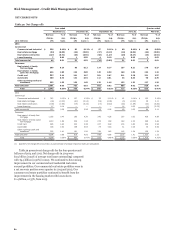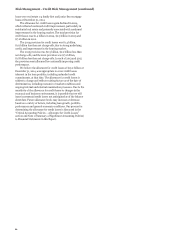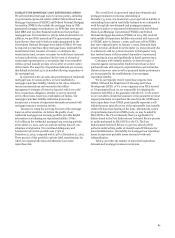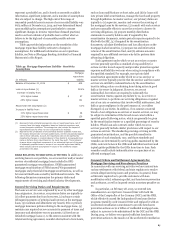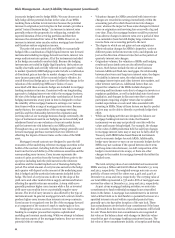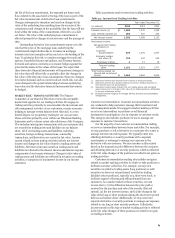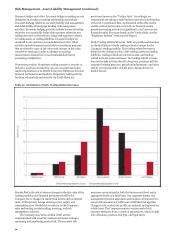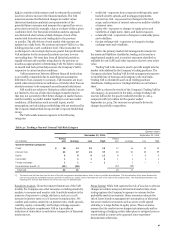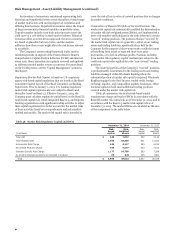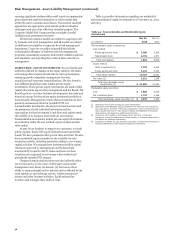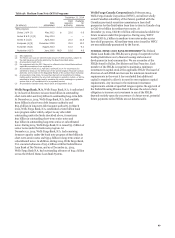Wells Fargo 2014 Annual Report Download - page 91
Download and view the complete annual report
Please find page 91 of the 2014 Wells Fargo annual report below. You can navigate through the pages in the report by either clicking on the pages listed below, or by using the keyword search tool below to find specific information within the annual report.
the life of the loan commitment, the expected net future cash
flows related to the associated servicing of the loan as part of the
fair value measurement of derivative loan commitments.
Changes subsequent to inception are based on changes in fair
value of the underlying loan resulting from the exercise of the
commitment and changes in the probability that the loan will not
fund within the terms of the commitment, referred to as a fall-
out factor. The value of the underlying loan commitment is
affected primarily by changes in interest rates and the passage of
time.
Outstanding derivative loan commitments expose us to the
risk that the price of the mortgage loans underlying the
commitments might decline due to increases in mortgage
interest rates from inception of the rate lock to the funding of the
loan. To minimize this risk, we employ mortgage forwards and
options, Eurodollar futures and options, and Treasury futures,
forwards and options contracts as economic hedges against the
potential decreases in the values of the loans. We expect that
these derivative financial instruments will experience changes in
fair value that will either fully or partially offset the changes in
fair value of the derivative loan commitments. However, changes
in investor demand, such as concerns about credit risk, can also
cause changes in the spread relationships between underlying
loan value and the derivative financial instruments that cannot
be hedged.
MARKET RISK - TRADING ACTIVITIES The Finance
Committee of our Board of Directors reviews the acceptable
market risk appetite for our trading activities. We engage in
trading activities primarily to accommodate the investment and
risk management activities of our customers, execute economic
hedging to manage certain balance sheet risks and, to a very
limited degree, for proprietary trading for our own account.
These activities primarily occur within our Wholesale Banking
businesses and to a lesser extent other divisions of the Company.
This includes entering into transactions with our customers that
are recorded as trading assets and liabilities on our balance
sheet. All of our trading assets and liabilities, including
securities, foreign exchange transactions, commodity
transactions, and derivatives are carried at fair value. Income
earned related to these trading activities include net interest
income and changes in fair value related to trading assets and
liabilities. Net interest income earned on trading assets and
liabilities is reflected in the interest income and interest expense
components of our income statement. Changes in fair value of
trading assets and liabilities are reflected in net gains on trading
activities, a component of noninterest income in our income
statement.
Table 45 presents total revenue from trading activities.
Table 45: Income from Trading Activities
Year ended December 31,
(in millions) 2014 2013 2012
Interest income (1) $ 1,685 1,376 1,358
Less: Interest expense (2) 382 307 245
Net interest income 1,303 1,069 1,113
Noninterest income:
Net gains from trading
activities (3):
Customer
accommodation 924 1,278 1,347
Economic hedges
and other (4) 233 332 345
Proprietary trading 4 13 15
Total net trading
gains 1,161 1,623 1,707
Total trading-related net
interest and noninterest
income $ 2,464 2,692 2,820
(1) Represents interest and dividend income earned on trading securities.
(2) Represents interest and dividend expense incurred on trading securities we
have sold but have not yet purchased.
(3) Represents realized gains (losses) from our trading activity and unrealized
gains (losses) due to changes in fair value of our trading positions, attributable
to the type of business activity.
(4) Excludes economic hedging of mortgage banking activities and asset/liability
management.
Customer accommodation Customer accommodation activities
are conducted to help customers manage their investment and
risk management needs. We engage in market-making activities
or act as an intermediary to purchase or sell financial
instruments in anticipation of or in response to customer needs.
This category also includes positions we use to manage our
exposure to customer transactions.
For the majority of our customer accommodation trading,
we serve as intermediary between buyer and seller. For example,
we may purchase or sell a derivative to a customer who wants to
manage interest rate risk exposure. We typically enter into
offsetting derivative or security positions with a separate
counterparty or exchange to manage our exposure to the
derivative with our customer. We earn income on this activity
based on the transaction price difference between the customer
and offsetting derivative or security positions, which is reflected
in the fair value changes of the positions recorded in net gains on
trading activities.
Customer accommodation trading also includes net gains
related to market-making activities in which we take positions to
facilitate customer order flow. For example, we may own
securities recorded as trading assets (long positions) or sold
securities we have not yet purchased, recorded as trading
liabilities (short positions), typically on a short-term basis, to
facilitate support of buying and selling demand from our
customers. As a market maker in these securities, we earn
income due to: (1) the difference between the price paid or
received for the purchase and sale of the security (bid-ask
spread), (2) the net interest income, and (3) the change in fair
value of the long or short positions during the short-term period
held on our balance sheet. Additionally, we may enter into
separate derivative or security positions to manage our exposure
related to our long or short security positions. Collectively,
income earned on this type of market-making activity is reflected
in the fair value changes of these positions recorded in net gain
on trading activities.
89



